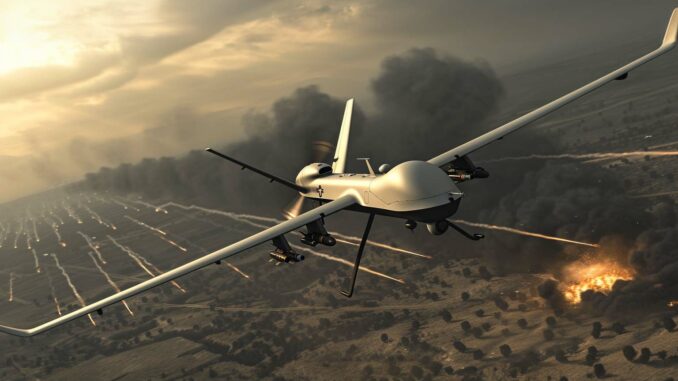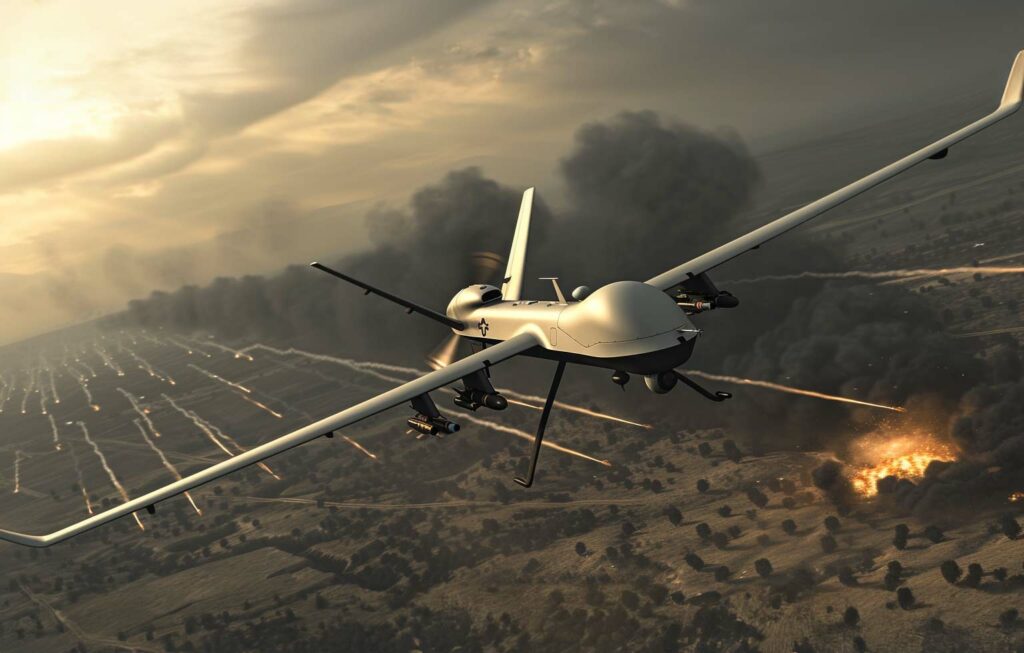
Find out how Ukraine is using UAVs and USVs to strike economic targets in Russia and the impact on the ongoing conflict.
In brief
Ukraine, in response to the Russian invasion, is using unmanned aerial vehicles (UAVs) and unmanned surface vehicles (USVs) to carry out attacks on economic targets inside Russia. These attacks have caused significant damage to Russian infrastructure, such as the Kerch Bridge and fuel storage facilities, forcing Russia to relocate its Black Sea fleet and face major political and logistical embarrassments.
Context of the Conflict and Population Displacement
Before Russia invaded Ukraine in 2022, the country had a population of around 43 million. Following the fighting, the population dropped to 37.7 million in 2024, with over 30% of the population internally displaced. These massive displacements are the direct result of Russia’s ongoing attacks on Ukrainian civilian infrastructure, in an attempt to demoralize the Ukrainian population and force a pro-Russian end to the conflict.
Use of Ukrainian UAVs and USVs
In the face of Russian aggression, Ukraine has developed and used its own UAVs and USVs to carry out strategic attacks on economic targets in Russia. For example, Ukrainian USVs have succeeded in damaging or destroying more than a third of Russia’s Black Sea fleet. This tactic forced Russian ships to retreat to safer ports over a thousand kilometers away in the Sea of Azov. These unmanned vehicles have proved highly effective in modern warfare, disrupting Russian naval operations and forcing costly strategic repositioning.

Impact on the Kerch Bridge
The 19-kilometer Kerch Bridge, linking mainland Russia to Crimea, was a prime target of the Ukrainian attacks. The bridge, which cost over four billion dollars, is crucial for Russian military supplies. Repeated Ukrainian attacks have rendered the bridge partially unusable, limiting traffic to one or two lanes at a time and complicating repairs. These actions not only disrupted Russian logistics operations, but also symbolized Ukraine’s ability to strike at vital infrastructure far beyond its borders.
Deep Attacks in Russia
Ukrainian UAVs were used to carry out deep attacks up to a thousand kilometers inside Russian territory. These strikes targeted and severely damaged fuel storage sites, military installations and factories producing equipment for the Russian army. The consequences of these attacks were immediate: fuel shortages for local vehicles, disruption of Russian oil exports, and political embarrassment for the Russian government. The attacks also revealed the shortcomings of Russian air defense, which was unable to prevent repeated incursions.
Advantages and disadvantages of the Ukrainian attacks
Ukraine’s use of UAVs and USVs offers several strategic advantages. These technologies enable precise strikes on critical targets with minimal risk to operators. What’s more, they create constant pressure on Russia, forcing costly redeployments and disrupting supply lines. However, these attacks are not without their drawbacks. They can exacerbate international tensions and lead to severe retaliation on Russia’s part. What’s more, dependence on technology requires ongoing investment in development and maintenance.
Political and strategic consequences
The Ukrainian attacks have significant political and strategic repercussions. They have exposed the vulnerability of Russia’s critical infrastructure and embarrassed the Russian government, particularly in Moscow. For Russian civilians and international observers, the attacks revealed a reality of the conflict that the Russian government had tried to play down. Internally, they intensified criticism of the government’s ability to protect the national territory and manage the war effectively.
Extrapolation and the future of the conflict
The effectiveness of Ukrainian UAVs and USVs could transform modern warfare tactics. These technologies offer a glimpse into the future of conflict, where precise strikes and remote operations will play a crucial role. For Ukraine, continuing to develop and deploy these technologies will be essential to maintain pressure on Russia and deter future aggression. At the same time, the international community will need to consider the implications of these technologies for global stability and international humanitarian law.
Ukraine’s special operations, using UAVs and USVs, have changed the dynamics of the conflict with Russia. By inflicting significant damage on Russian economic and military infrastructure, Ukraine has demonstrated its ability to carry out effective strikes far beyond its borders. These actions, while posing ethical and strategic challenges, illustrate the evolution of modern warfare and the need for continuous adaptation to new technologies.
War Wings Daily is an independant magazine.